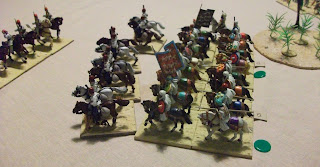For the last few weeks Steve and I have been joined by another gamer, David, for our weekly skype/zoom game sessions. David has hosted a couple of games and this is the most recent.
 |
| The initial deployments; Sassanids nearest the camera |
A Roman army has invaded Sassanid territory and the local Satrap has raised a force to oppose them. The Sassanids have positioned their infantry behind a dried up river bed, to offset the Roman infantry's numerical and quality superiority. On the more open terrain the best Sassanid troops the cataphracts and supporting light cavalry have a clear run at the Roman cavalry. The Sassanid objective is to hold their position and prevent the Romans from advancing further east. For the Romans, they need to break through this force and head for the Sassanid capital.
Having won the initiative, the Roman forces (or at least most of them), advanced rapidly and soon the opposing light cavalry were in missile range exchanging arrows and javelins. As is the nature of light cavalry they proved rather 'skittish' falling back after taking casualties and evading at top speed from charges. Both generals were having difficulty persuading their heavy cavalry to actually move forward and the centre of action moved to the centre where one of the Roman heavy infantry units was closing up to the river bed.
The Roman commander deployed his light troops to the flank to shoot on the Sassanid levy and unsettle them before the heavy infantry charged. The light troops were driven off by a charge from the reserve unit of cataphracts, but the cavalry were unable to catch the infantry before they reined in. Undeterred, the Roman heavy infantry charged across the dried up river bed and into the levy. Against the odds, the levy held then counter-attacked and pushed the Romans back. The Roman general decided to bring forward his second unit of heavy infantry and charge the now weakened levy. They passed through their reforming comrades and readied for the charge. Unfortunately, the Roman general rolled a 'blunder' at this point and followed it up with a '1'. This sent the fresh unit back through the other heavy infantry in disorder, stalling this section of the infantry attack.
 |
| The Sassanid right turn to face the threat from the Roman archers |
On the Roman left, one unit of archers was skirmishing with the Sassanid javelin men covering the front of their spearmen, whilst the second unit embarked on a flank march through the woods, intending to fall on the flank of the levy on the Sassanid right. Surprisingly, the javelins got the better of the archers, who had to fall back after becoming disordered.. On the flank, once the Roman archers had reached their position and shot at the levy, the levy turned and then returned the favour much more effectively; forcing those archers to fall back disordered as well. On the right flank of the Roman line the skirmishers had moved forward again to try their luck against the weakened Sassanid levy. Once again the reserve cataphracts charged to drive them off. This time they caught the skirmishers and destroyed them.
 |
| The cataphracts catch the Roman skirmishers |
Back on the Roman right, the heavy cavalry were lumbering forward, although the Roman units had moved out of supporting distance of each other. At just the right moment the Sassanid cavalry general managed to exert his authority and get his cataphracts moving. One charged the isolated Roman heavy cavalry unit, the other supported them in their charge. In this devastating charge the Sassanid cataphracts broke the Roman unit and drove it from the field.
 |
| The Sassanid cataphracts drive off the Roman cavalry |
This was the decisive moment of the battle. The Roman infantry line was now open on its right flank and the reserve Sassanid cataphract unit was well-placed to exploit this weakness. The remaining Roman heavy cavalry unit was outnumbered and the rival light cavalry forces were fighting each other to a standstill. With his infantry having made no headway against the Sassanid infantry the Roman general had little option but to pull back.
Many thanks to David for hosting the game. It was enjoyable and though we both had our difficulties with getting units to do what we wanted it was a balanced scenario. The rules had sufficient similarities to our version of Pike and Shotte so as to be fairly easy to use. The main differences being the mechanism whereby one side moves and shoots whilst the opposition do nothing, and rolling a '6' whilst shooting imposes a test on the opposition. All the troops were David's and he took the photos.












